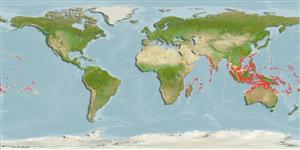分类 / Names
俗名 | 同种异名 | Catalog of Fishes(属, 种) | ITIS | CoL | WoRMS | Cloffa
Teleostei >
Anguilliformes (Eels and morays)
鰻目 (Eels and morays) >
Muraenidae (Moray eels)
鯙科 (Moray eels) > Muraeninae
Etymology: Rhinomuraena: Greek, rhinos = nose + Latin, muraena = morey eel (Ref. 45335).
More on author: Garman.
Environment: milieu / climate zone / depth range / distribution range
生态学
海洋 礁区鱼类; 非迁移的; 深度上下限 1 - 67 m (Ref. 90102). 热带; 32°N - 26°S
Indo-Pacific: East Africa to the Tuamoto Islands, north to southern Japan, south to New Caledonia and French Polynesia; including Marianas and Marshalls.
印度-太平洋: 东非到 Tuamoto 岛, 北至日本南部, 南至新加勒多尼亚与法属玻里尼西亚; 包括马里亚纳群岛与马绍尔群岛。
Length at first maturity / 大小 / 重量 / 年龄
Maturity: Lm 107.0, range 94 - 120 cm
Max length : 130 cm TL 雄鱼/尚未辨别雌雄; (Ref. 2334)
背棘 (总数): 0; 臀棘 0; 脊椎骨: 270 - 286. Has three fleshy tentacles on the tip of its lower jaw, a single fleshy pointed projection at the tip of its snout, and tubular anterior nostrils ending in gaudy, fanlike expansions.
在它的下颌的顶端上有三个肉质的触须, 一个肉质的尖突出在吻尖上, 与管状的前鼻孔末端形成风扇状的膨胀。
Adults occur in lagoon and seaward reefs. They are secretive species normally hidden in sand or rubble, sometimes with only its head protruding. Feed on small fishes (Ref. 9710, 48635, 75154, 89972). Juveniles all black, males have yellow dorsal fin and females change to a nearly all yellow color, but usually with blue in the posterior (Ref. 48635). Only moray that undergoes abrupt changes in coloration and sex: it is a protandrous hermaphrodite, i.e., functioning males reverse sex to become females. Protandry is diagnosed based on colouration, but not confirmed (Ref. 103751).
常见于印度尼西亚。 (参考文献 48635) 出现于泻湖与临海礁石。 吃小鱼。 通常在沙子或者碎石被藏的躲躲藏藏的种, 只有时有它的头部凸出。 (参考文献 9710,48635) 稚鱼全黑的, 雄鱼有黄色的背鳍与雌性变成一个几乎全黄的颜色, 但是在后面的中通常有蓝色.(参考文献 48635) 只有海鳗历经突然的改变体色与性别: 它是一个雄蕊先熟的雌雄同体,也就是,运作雄性转换性别成为雌性。
Life cycle and mating behavior
成熟度 | 繁殖 | 产卵场 | 卵 | 孕卵数 | 仔鱼
Protandry is diagnosed based on colouration, but not confirmed (Ref. 103751).印度-太平洋: 东非到 Tuamoto 岛, 北至日本南部, 南至新加勒多尼亚与法属玻里尼西亚; 包括马里亚纳群岛与马绍尔群岛。
Chen, H.-M., K.-T. Shao and C.T. Chen, 1994. A review of the muraenid eels (Family Muraenidae) from Taiwan with descriptions of twelve new records. Zool. Stud. 33(1):44-64. (Ref. 6934)
人类利用
水族馆: 商业性
更多信息
参考文献养殖养殖信息品种遗传学Electrophoreses遗传率疾病加工NutrientsMass conversion
合作者照片Stamps, Coins Misc.声音神经毒速度泳型鳃区Otoliths脑重体重比眼睛色素
工具
特别资料
下载 XML
网络资源
Estimates based on models
Preferred temperature (Ref.
123201): 24.6 - 28.8, mean 27.5 °C (based on 552 cells).
Phylogenetic diversity index (Ref.
82804): PD
50 = 1.0000 [Uniqueness, from 0.5 = low to 2.0 = high].
Bayesian length-weight: a=0.00050 (0.00025 - 0.00101), b=3.26 (3.10 - 3.42), in cm total length, based on LWR estimates for this (Sub)family-body shape (Ref.
93245).
营养阶层 (Ref.
69278): 4.5 ±0.80 se; based on food items.
回复力 (Ref.
120179): 非常低的, 最小族群倍增时间超过14 年 (Preliminary K or Fecundity.).
Fishing Vulnerability (Ref.
59153): Very high vulnerability (78 of 100).
Nutrients (Ref.
124155): Calcium = 22.6 [12.0, 35.3] mg/100g; Iron = 0.436 [0.257, 0.889] mg/100g; Protein = 18.8 [16.6, 21.4] %; Omega3 = 0.102 [0.046, 0.293] g/100g; Selenium = 49.2 [25.9, 97.7] μg/100g; VitaminA = 86.8 [25.0, 291.3] μg/100g; Zinc = 0.721 [0.498, 1.001] mg/100g (wet weight);
